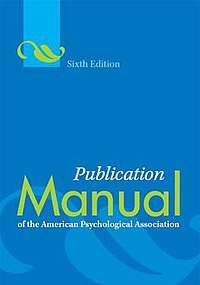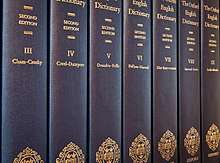APA style

APA style is a writing style and format for academic documents such as scholarly journal articles and books. It is commonly used for citing sources within the field of social sciences. It is described in the style guide of the American Psychological Association (APA), which is titled the Publication Manual of the American Psychological Association. The guidelines were developed to aid reading comprehension in the social and behavioral sciences, for clarity of communication, and for "word choice that best reduces bias in language".[1][2]
APA style is widely used, either entirely or with modifications, by hundreds of other scientific journals (including medical and other public health journals), in many textbooks, and in academia (for papers written in classes). Along with AMA Style and CSE Style, it is one of the major styles for such work.
History
The APA got involved in journal publishing in 1923.[3] In 1929, an APA committee had a seven-page writer's guide published in the Psychological Bulletin.[4][5] In 1944, a 32-page guide appeared as an article in the same journal.[3] The first edition of the APA Publication Manual was published in 1952 as a 61-page supplement to the Psychological Bulletin,[6] marking the beginning of a recognized “APA style.”[3] In response to the growing complexities of scientific reporting, subsequent editions were released in 1974, 1983, 1994, 2001, and 2009.
Primarily known for the simplicity of its reference citation style, the Manual also established standards for language use that had far-reaching effects. Particularly influential were the "Guidelines for Nonsexist Language in APA Journals," first published as a modification to the 1974 edition, which provided practical alternatives to "sexist" language then in common usage.[7][8] The guidelines for reducing bias in language have been updated over the years and presently provide practical guidance for writing about race, ethnicity, age, gender, sexual orientation, and disability status (APA, 2009, pp. 70–77; see also APA, 2009b).[9]
Sixth edition of the Publication Manual
The sixth edition of the Publication Manual of the American Psychological Association is the most current. It was released in July 2009 after four years of development. The Publication Manual Revision Task Force of the American Psychological Association established parameters for the revision based on published critique; user comments; commissioned reviews; and input from psychologists, nurses, librarians, business leaders, publishing professionals, and APA governance groups (APA, 2007a, 2007b).[10][11] To accomplish these revisions, the Task Force appointed working groups of four to nine members in seven areas: bias-free language, ethics, graphics, Journal Article Reporting Standards,[12] references, statistics, and writing style (APA, 2009, pp. XVII–XVIII).
The APA explained the issuing of a new edition only eight years after the fifth edition by pointing to the increased use of online source or online access to academic journals (6th edition, p. XV). The sixth edition is accompanied by a style website, apastyle.org as well as the APA Style Blog, which answers many common questions from users.
Errors in the first printing
Sample papers in the first printing of the sixth edition contained errors. APA staff posted all of the corrections online for free in a single document on October 1, 2009, and shortly thereafter alerted users to the existence of the corrections in an APA blog entry.[13] These errors attracted significant attention from the scholarly community and nearly two weeks later, on October 13, 2009, the article "Correcting a Style Guide" was published in the online newspaper Inside Higher Ed that included interviews with several individuals, one of whom described the errors as "egregious".[14] All copies of the printing with errors were soon after recalled in 2009 (including those from major retailers such as Amazon.com) and all manuals currently in circulation are unaffected.
Characteristics of APA Style Citation
APA style is complex.[15][16] Only a sample of citation and reference formats can be listed here.
In-text citations
APA Style uses an author-date reference citation system in the text with an accompanying reference list. That means that to cite any reference in a paper, the writer should cite the author and year of the work, either by putting both in parentheses separated by a comma (parenthetical citation) or by putting the author in the narrative of the sentence and the year in parentheses (narrative citation).
Example narrative citation: Schmidt and Oh (2016) described a fear among the public that the findings of science are not actually real.
Example parenthetical citation: In our postfactual era, many members of the public fear that the findings of science are not real (Schmidt & Oh, 2016).
Reference list
In the APA reference list, the writer should provide the author, year, title, and source of the cited work in an alphabetical list of references. If a reference is not cited in the text, it should not be included in the reference list. The reference format varies slightly depending on the document type (e.g., journal article, edited book chapter, blog post), but broadly speaking always follows the same pattern of author, date, title, source.
| Reference type | Template | Example |
|---|---|---|
| Journal article | Author, A., & Author, B. (year). Title of article. Journal Title, Volume, page range. DOI | Schmidt, F. L., & Oh, I.-S. (2016). The crisis of confidence in research findings in psychology: Is lack of replication the real problem? Or is it something else? Archives of Scientific Psychology, 4, 32–37. https://dx.doi.org/10.1037/arc0000029 |
| Whole book | Author, A., & Author, B. (year). Title of book. Publisher location: Publisher Name. DOI | Brown, B. (2010). The gifts of imperfection: Let go of who you think you're supposed to be and embrace who you are. Center City, MN: Hazelden. |
| Edited book chapter | Author, A., & Author, B. (year). Title of chapter. In E. Editor & A. Editor (Eds.), Title of book (pp. xx-xx). Publisher location: Publisher Name. DOI | Singh, A. A., Hwahng, S. J., Chang, S. C., White, B. (2017). Affirmative counseling with trans/gender-variant people of color. In A. Singh & L. M. Dickey (Eds.), Affirmative counseling and psychological practice with transgender and gender nonconforming clients (pp. 41–68). Washington, DC: American Psychological Association. https://dx.doi.org/10.1037/14957-003 |
| Website | Group Author. (year). Title of page. Retrieved from http://xxxxxxx on date | American Psychological Association. (n.d.). Divisions. Retrieved from http://www.apa.org/about/division/ on 2011-07-23 |
- Note that the title of a website reference may be italic or not italic. If the work stands alone, italicize the title; if it is part of a greater whole, do not italicize the title.
See also
References
- ↑ The Publication Manual of the American Psychological Association (6th ed.). Washington, DC: American Psychological Association. 2010. ISBN 978-1-4338-0562-2.
- ↑ "APA Style". Washington, DC: American Psychological Association. Retrieved October 27, 2011.
- 1 2 3 VandenBos, Gary R. (1992). "The APA Knowledge Dissemination Program: An overview of 100 years". In Rand B. Evans, Virginia Staudt Sexton, Thomas C. Cadwallader (eds.). The American Psychological Association: A Historical Perspective. Washington, DC: American Psychological Association. pp. 347–390. ISBN 978-1-55798-136-3.
- ↑ Bentley, M.; Peerenboom, C.A.; Hodge, F.W.; Passano, Edward B.; Warren, H.C.; Washburn, M.F (February 1929). "Instructions in regard to preparation of manuscript". Psychological Bulletin. 26 (2): 57–63. doi:10.1037/h0071487. ISSN 0033-2909.
- ↑ "APA Style Blog: The Origins of APA Style". blog.apastyle.org. Retrieved 2016-12-14.
- ↑ APA Publications and Communications Board Working Group on Journal Article Reporting Standards (December 2008). "Reporting Standards for Research in Psychology: Why Do We Need Them? What Might They Be?" (PDF). American Psychologist. 63 (9): 839–851. doi:10.1037/0003-066x.63.9.839. PMC 2957094.
- ↑ APA Task Force on Issues of Sexual Bias in Graduate Education (June 1975). "Guidelines for nonsexist use of language". American Psychologist. Washington, DC: American Psychological Association. 32 (6): 487–494. doi:10.1037/h0076869. ISSN 0003-066X. OCLC 696450842. Retrieved October 27, 2011.
- ↑ APA Publication Manual Task Force (June 1977). "Guidelines for nonsexist language in APA journals [Change Sheet 2]". American Psychologist. Washington, DC: American Psychological Association. 30 (6): 682–684. doi:10.1037/0003-066X.32.6.487. ISSN 0003-066X. OCLC 696450842. Retrieved October 27, 2011.
- ↑ "Supplemental materials: Chapter 3: Writing Clearly and Concisely". Washington, DC: American Psychological Association. Retrieved October 27, 2011.
- ↑ American Psychological Association (April 13–14, 2007). Meeting of the Council of Editors (Agenda book). Washington, D.C.: APA Archives.
- ↑ American Psychological Association (May 18–20, 2007). Meeting of the Publications and Communications Board (Agenda book). Washington, D.C.: APA Archives.
- ↑ APA Publications and Communications Board Working Group on Journal Article Reporting Standards (2008). "Reporting Standards for Research in Psychology: Why Do We Need Them? What Might They Be?" (PDF). American Psychologist. 63: 839–851. doi:10.1037/0003-066x.63.9.839. PMC 2957094.
- ↑ Skutley, Mary Lynn (October 8, 2009). "Note to APA Style Community: Sixth Edition Corrections". APA blog.
- ↑ Epstein, Jennifer (October 13, 2009). Jaschik, Scott; Lederman, Doug, eds. "Correcting a Style Guide". Inside Higher Ed. Washington, DC: Inside Higher Ed. Retrieved October 27, 2011.
- ↑ Swidrak, Carolyn (27 August 2018). "APA - How to Cite Your Sources". Overview & Citation Guide Portal. Regis. Retrieved 6 October 2018.
APA format is complex and takes time to learn.
- ↑ Endnote X, Thomson, 2006,
The APA style is a very complex style.
Bibliography
- The Publication Manual of the American Psychological Association (6th ed.). Washington, DC: American Psychological Association. 2010. ISBN 978-1-4338-0562-2. (spiral bound)
- The Publication Manual of the American Psychological Association (5th ed.). Washington, DC: American Psychological Association. 2001. ISBN 978-1-55798-791-4.
External links
| Wikiversity has learning resources about APA style |
- "Download APA format template". normas-apa.com.
- "American Psychological Association". apa.org.
- "APA Style". apastyle.org.
- APA Formatted Paper Template at Indian River State College's Library site.
- Generate APA citations based on DOI, ISBN and URL.
- Interactive APA at Massey University's OWLL site.
- APA resources at Purdue University's Online Writing Lab
- Formatting APA Style in MS Word 2013
- APA Citation Generator
